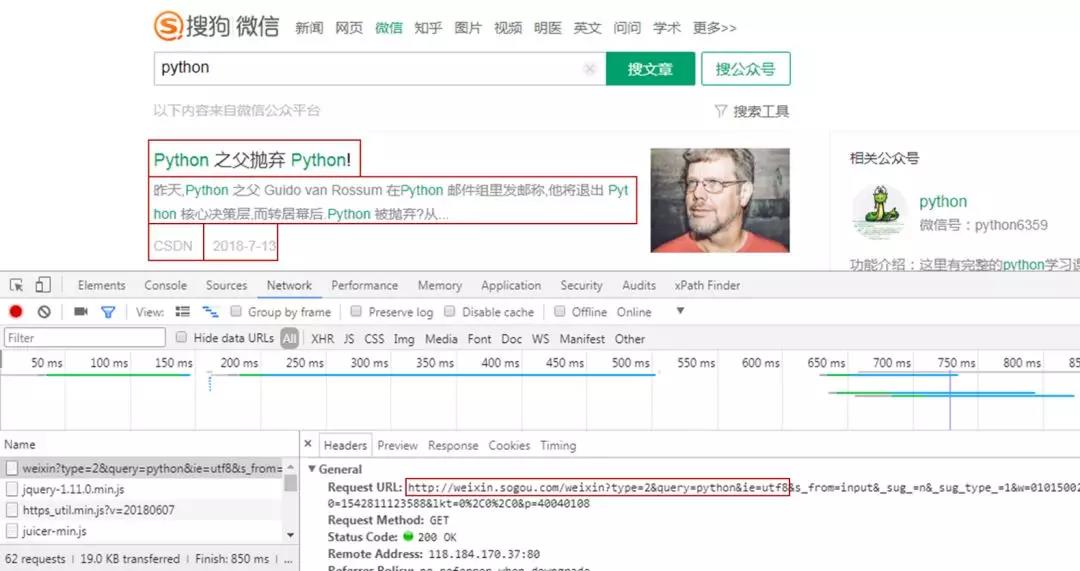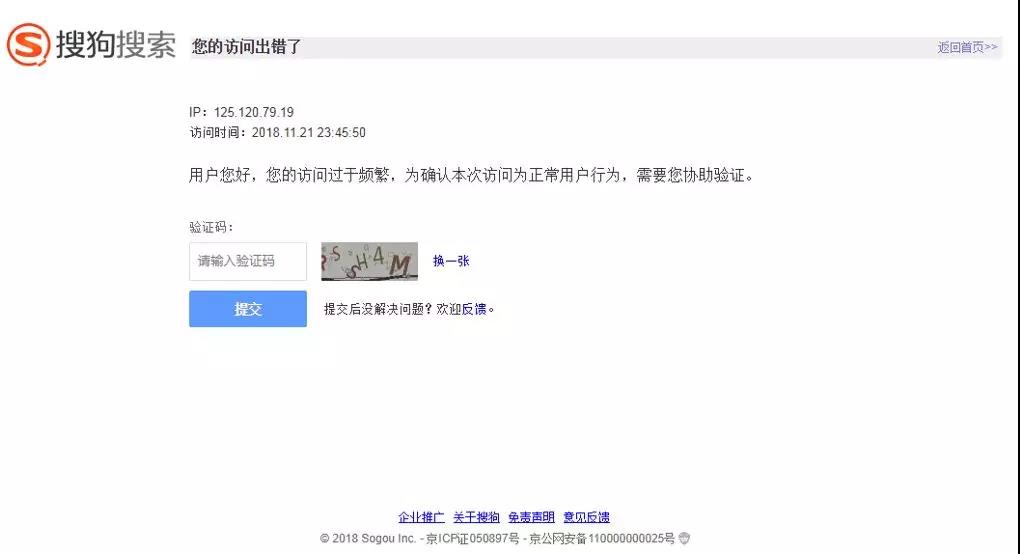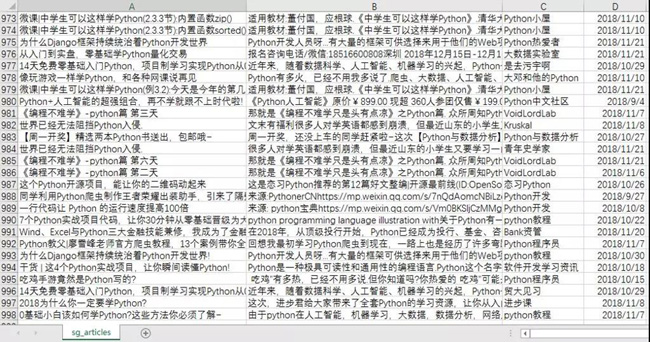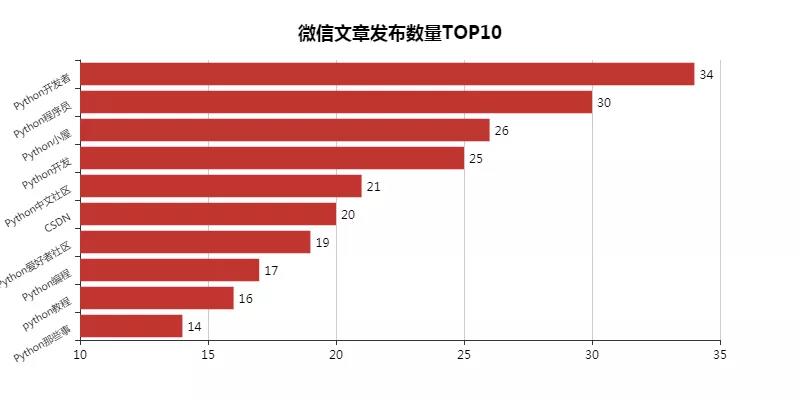有态度地学习
之前讲了代理池以及Cookies的相关知识,这里针对搜狗搜索微信公众号文章的爬取,将它俩实践一下。
在崔大的书里面,他是用代理IP来应对搜狗的反爬措施,因为同一IP访问网页过于频繁,就会跳转验证码页面。
不过时代在进步,搜狗搜索的反爬也在更新,现在它是IP加Cookies双重把关。
01 网页分析
获取微信公众号文章信息,标题、开头、公众号、发布时间。
请求方式为GET,请求网址为红框部分,后面的信息没什么用。
02 反爬破解
什么时候出现上图这种情况呢?
两种,一种同一个IP重复访问页面,另一种同一个Cookies重复访问页面。
两个都有,挂的更快!完整爬取我只成功了一次...
因为我最开始就是先什么都不设置,然后就出现验证码页面。然后用了代理IP,还是会跳转验证码页面,直到***改变Cookies,才成功爬取。
01 代理IP设置
- def get_proxies(i):
- """
- 获取代理IP
- """
- df = pd.read_csv('sg_effective_ip.csv', header=None, names=["proxy_type", "proxy_url"])
- proxy_type = ["{}".format(i) for i in np.array(df['proxy_type'])]
- proxy_url = ["{}".format(i) for i in np.array(df['proxy_url'])]
- proxies = {proxy_type[i]: proxy_url[i]}
- return proxies
代理的获取以及使用这里就不赘述了,前面的文章有提到,有兴趣的小伙伴可以自行去看看。
经过我两天的实践,免费IP确实没什么用,两下子就把我真实IP揪出来了。
02 Cookies设置
- def get_cookies_snuid():
- """
- 获取SNUID值
- """
- time.sleep(float(random.randint(2, 5)))
- url = "http://weixin.sogou.com/weixin?type=2&s_from=input&query=python&ie=utf8&_sug_=n&_sug_type_="
- headers = {"Cookie": "ABTEST=你的参数;IPLOC=CN3301;SUID=你的参数;SUIR=你的参数"}
- # HEAD请求,请求资源的首部
- response = requests.head(url, headers=headers).headers
- result = re.findall('SNUID=(.*?); expires', response['Set-Cookie'])
- SNUID = result[0]
- return SNUID
总的来说,Cookies的设置是整个反爬中最重要的,而其中的关键便是动态改变SNUID值。
这里就不详细说其中缘由,毕竟我也是在网上看大神的帖子才领悟到的,而且领悟的还很浅。
成功爬取100页就只有一次,75页,50页,甚至到***一爬就挂的情况都出现了...
我可不想身陷「爬-反爬-反反爬」的泥潭之中,爬虫之后的事情才是我的真正目的,比如数据分析,数据可视化。
所以干票大的赶紧溜,只能膜拜搜狗工程师。
03 数据获取
1 构造请求头
- head = """
- Accept:text/html,application/xhtml+xml,application/xml;q=0.9,image/webp,image/apng,*/*;q=0.8
- Accept-Encoding:gzip, deflate
- Accept-Language:zh-CN,zh;q=0.9
- Connection:keep-alive
- Host:weixin.sogou.com
- Referer:'http://weixin.sogou.com/',
- Upgrade-Insecure-Requests:1
- User-Agent:Mozilla/5.0 (Windows NT 6.1; WOW64) AppleWebKit/537.36 (KHTML, like Gecko) Chrome/63.0.3239.132 Safari/537.36
- """
- # 不包含SNUID值
- cookie = '你的Cookies'
- def str_to_dict(header):
- """
- 构造请求头,可以在不同函数里构造不同的请求头
- """
- header_dict = {}
- header = header.split('\n')
- for h in header:
- h = h.strip()
- if h:
- k, v = h.split(':', 1)
- header_dict[k] = v.strip()
- return header_dict
2 获取网页信息
- def get_message():
- """
- 获取网页相关信息
- """
- failed_list = []
- for i in range(1, 101):
- print('第' + str(i) + '页')
- print(float(random.randint(15, 20)))
- # 设置延时,这里是度娘查到的,说要设置15s延迟以上,不会被封
- time.sleep(float(random.randint(15, 20)))
- # 每10页换一次SNUID值
- if (i-1) % 10 == 0:
- value = get_cookies_snuid()
- snuid = 'SNUID=' + value + ';'
- # 设置Cookies
- cookies = cookie + snuid
- url = 'http://weixin.sogou.com/weixin?query=python&type=2&page=' + str(i) + '&ie=utf8'
- host = cookies + '\n'
- header = head + host
- headers = str_to_dict(header)
- # 设置代理IP
- proxies = get_proxies(i)
- try:
- response = requests.get(url=url, headers=headers, proxies=proxies)
- html = response.text
- soup = BeautifulSoup(html, 'html.parser')
- data = soup.find_all('ul', {'class': 'news-list'})
- lis = data[0].find_all('li')
- for j in (range(len(lis))):
- h3 = lis[j].find_all('h3')
- #print(h3[0].get_text().replace('\n', ''))
- title = h3[0].get_text().replace('\n', '').replace(',', ',')
- p = lis[j].find_all('p')
- #print(p[0].get_text())
- article = p[0].get_text().replace(',', ',')
- a = lis[j].find_all('a', {'class': 'account'})
- #print(a[0].get_text())
- name = a[0].get_text()
- span = lis[j].find_all('span', {'class': 's2'})
- cmp = re.findall("\d{10}", span[0].get_text())
- #print(time.strftime("%Y-%m-%d", time.localtime(int(cmp[0]))) + '\n')
- date = time.strftime("%Y-%m-%d", time.localtime(int(cmp[0])))
- with open('sg_articles.csv', 'a+', encoding='utf-8-sig') as f:
- f.write(title + ',' + article + ',' + name + ',' + date + '\n')
- print('第' + str(i) + '页成功')
- except Exception as e:
- print('第' + str(i) + '页失败')
- failed_list.append(i)
- continue
- # 获取失败页码
- print(failed_list)
- def main():
- get_message()
- if __name__ == '__main__':
- main()
***成功获取数据。
04 数据可视化
1 微信文章发布数量***0
这里对搜索过来的微信文章进行排序,发现了这十位Python大佬。
这里其实特想知道他们是团队运营,还是个人运营。不过不管了,先关注去。
这个结果可能也与我用Python这个关键词去搜索有关,一看公众号名字都是带有Python的(CSDN例外)。
- from pyecharts import Bar
- import pandas as pd
- df = pd.read_csv('sg_articles.csv', header=None, names=["title", "article", "name", "date"])
- list1 = []
- for j in df['date']:
- # 获取文章发布年份
- time = j.split('-')[0]
- list1.append(time)
- df['year'] = list1
- # 选取发布时间为2018年的文章,并对其统计
- df = df.loc[df['year'] == '2018']
- place_message = df.groupby(['name'])
- place_com = place_message['name'].agg(['count'])
- place_com.reset_index(inplace=True)
- place_com_last = place_com.sort_index()
- dom = place_com_last.sort_values('count', ascending=False)[0:10]
- attr = dom['name']
- v1 = dom['count']
- bar = Bar("微信文章发布数量***0", title_pos='center', title_top='18', width=800, height=400)
- bar.add("", attr, v1, is_convert=True, xaxis_min=10, yaxis_rotate=30, yaxis_label_textsize=10, is_yaxis_boundarygap=True, yaxis_interval=0, is_label_show=True, is_legend_show=False, label_pos='right', is_yaxis_inverse=True, is_splitline_show=False)
- bar.render("微信文章发布数量***0.html")
2 微信文章发布时间分布
因为这里发现搜索到的文章会有2018年以前的,这里予以删除,并且验证剩下文章的发布时间。
毕竟信息讲究时效性,如果我搜索获取的都是老掉牙的信息,就没什么意思了,更何况还是在一直在变化的互联网行业。
- import numpy as np
- import pandas as pd
- from pyecharts import Bar
- df = pd.read_csv('sg_articles.csv', header=None, names=["title", "article", "name", "date"])
- list1 = []
- list2 = []
- for j in df['date']:
- # 获取文章发布年份及月份
- time_1 = j.split('-')[0]
- time_2 = j.split('-')[1]
- list1.append(time_1)
- list2.append(time_2)
- df['year'] = list1
- df['month'] = list2
- # 选取发布时间为2018年的文章,并对其进行月份统计
- df = df.loc[df['year'] == '2018']
- month_message = df.groupby(['month'])
- month_com = month_message['month'].agg(['count'])
- month_com.reset_index(inplace=True)
- month_com_last = month_com.sort_index()
- attr = ["{}".format(str(i) + '月') for i in range(1, 12)]
- v1 = np.array(month_com_last['count'])
- v1 = ["{}".format(int(i)) for i in v1]
- bar = Bar("微信文章发布时间分布", title_pos='center', title_top='18', width=800, height=400)
- bar.add("", attr, v1, is_stack=True, is_label_show=True)
- bar.render("微信文章发布时间分布.html")
3 标题、文章开头词云
- from wordcloud import WordCloud, ImageColorGenerator
- import matplotlib.pyplot as plt
- import pandas as pd
- import jieba
- df = pd.read_csv('sg_articles.csv', header=None, names=["title", "article", "name", "date"])
- text = ''
- # for line in df['article'].astype(str):(前文词云代码)
- for line in df['title']:
- text += ' '.join(jieba.cut(line, cut_all=False))
- backgroud_Image = plt.imread('python_logo.jpg')
- wc = WordCloud(
- background_color='white',
- mask=backgroud_Image,
- font_path='C:\Windows\Fonts\STZHONGS.TTF',
- max_words=2000,
- max_font_size=150,
- random_state=30
- )
- wc.generate_from_text(text)
- img_colors = ImageColorGenerator(backgroud_Image)
- wc.recolor(color_func=img_colors)
- plt.imshow(wc)
- plt.axis('off')
- # wc.to_file("文章.jpg")(前文词云代码)
- wc.to_file("标题.jpg")
- print('生成词云成功!')
公众号文章标题词云,因为是以Python这个关键词去搜索的,那么必然少不了Python。
然后词云里出现的的爬虫,数据分析,机器学习,人工智能。就便知道Python目前的主要用途啦!
不过Python还可用于Web开发,GUI开发等,这里没有体现,显然不是主流。
公众号文章开头词云,记得以前写作文的时候,老师不就说过开头基本决定了你的分数,所以一定要开头引用一下名人的话(古人有云...)。
那么公众号文章应该也不例外,不过这里呢,我倒是感觉到了不少广告的气息...
当然数据分析,机器学习,人工智能同样也还在其中,是不是培训广告的噱头我就不知道了。
就像之前在一个公号里看到的一句话,仿佛学会了Python就会人工智能,又仿佛要学习人工智能就必须学习Python,那么真是这样吗???
相信答案就在大家心中!















































